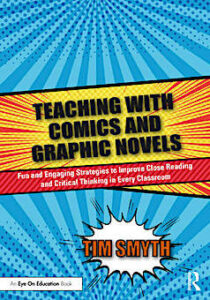Add Comics and Graphic Novels to All Classes
Teaching with Comics and Graphic Novels: Fun and Engaging Strategies to Improve Close Reading and Critical Thinking in Every Classroom
By Tim Smyth
Routledge/Eye On Education, 2023 – Learn more)
Reviewed by Kevin Hodgson

This giant book was all of the original Bone stories gathered together, more than 1,300 pages of graphic novel that tell the stories of three cousins from Boneville trying to find their way back home (Bone is an echo of The Odyssey that took Jeff Smith ten years to write.)
The hours I spent in Jeff Smith’s creative landscape were an eye-opening literary adventure for me, a reminder of how a comic merges visual with text to create a powerful literacy experience.
Comics=Literacy

Smyth opens the book by making a clear connection that reading and making comics is a literacy endeavor, and then lays out the case for any teachers still reluctant and resistant to comics in the classroom (are there still some of those out there?).
Visual literacy, levels of vocabulary, and other topics are the framework for his case that comics equal literacy. On social media he even wears a t-shirt with that slogan emblazoned on his chest.
Smyth shares his lifelong love of comics and his own story of first not sharing that love with his high school students Then he had a light-bulb moment of how his passion for comics and sequential art could inspire his students, and himself, in the classrooms where he found himself getting slightly bored as an educator and where he noticed a lack of love of reading in some of his students.
He pursued a program for reading certification and then dove into a mission of weaving comics and graphic novels into his curriculum, He then began sharing his work with others on social media, blogs and other platforms (see @historycomics).
Comics as art and primary source material
Teaching with Comics and Graphic Novels is a primer on how to read comics as an art form, because Smyth has found that many students and teachers do not understand the flow of story narrative and art on the page.
We learn how to integrate comics into cross-curricular lessons around reading, with helpful one-page comics for classroom use around topics like sequence and inferential thinking; and on how to use graphic novels, like John Lewis’ March series, as textual partners to other novels and articles, sparking discussions and writing in the classroom setting.
I was particularly intrigued by his exploration of “comics as artifacts.” Smyth explores the idea that comics from different eras capture the sense of those eras and, therefore, can be used as textual artifacts for inquiry.
One example he uses is a Superman comic that was inspired by fears of Nuclear War (Superman is the last being alive on the planet). As an artifact, the comic gives voice to the fears of the Cold War and the notions of what a hero is, and Smyth shows how he uses this story to enhance lessons around World War II and its aftermath on societies.
The March series, which recounts historical events from the 1960s, is another good example. Smyth shows how the late Congressman Lewis’ graphic memoir (in three books) is a first-hand account of organizers of the nascent Civil Rights Movement.
Smyth also tackles immigration, disabilities, the 9-11 attacks, war in the Middle East, memoir writing and other important but difficult topics, by sharing resources from the field of comics, weaving in advice on how graphic arts can help students better understand complicated topics through illustrated stories.
He also explores comic adaptations of familiar classroom novels – such as Speak by Laura Halse or A Wrinkle in Time by Madeleine L’Engle – or Romeo and Juliet by William Shakespeare. Smyth touts the value of seeing a story in another format.
He also cautions us to use discretion, reminding teachers to research the adaptations, as there are definitely some graphic versions of the classics that are done poorly – although perhaps that in itself is an interesting lesson in story interpretation.
Resources to use in any discipline
This book is chock-full of prompts, lesson ideas, and handouts that any teacher in any discipline could easily adapt for the classroom, today or tomorrow or next week. Smyth’s love of comics is evident throughout, and that passion spills over into the pages of his book.
It’s worth reminding ourselves as teachers that we probably all have students who love comics and graphic novels and may still be a bit hesitant to say so in a classroom where comics are not considered “proper reading material.”
We also may have writers whose impulse is to mix art and words to create stories and other texts but who don’t think they have permission to do so. As teachers, we have to be open to those creative avenues as much as possible, and advocates like Smyth help us all find that path forward.
Shifting students from comics readers to comics creators
Finally, I want to give a shout of thanks to Smyth for diving into the making of comics in the classroom, too, and the shift from reader to writer/creator that Smyth nods to late in the book. While I wished there were more here about the art of making comics, the discussions about how to go about bringing graphic storytelling into a learning setting – using hand-drawn panels, online webcomic sites, or even photography with speech bubbles – is an important shift for students. As they move from reader to writer to artist in a different medium, they are challenged to consider many variables in composition.
Kevin Hodgson is a sixth grade teacher in Southampton, Massachusetts and a teacher-consultant with the Western Massachusetts Writing Project. Kevin blogs regularly at Kevin’s Meandering Mind and tweets more often than is healthy under his @dogtrax handle. For several years, he wrote a regular blog here at MiddleWeb: Working Draft. He is also a participant of the CLMOOC network.






























